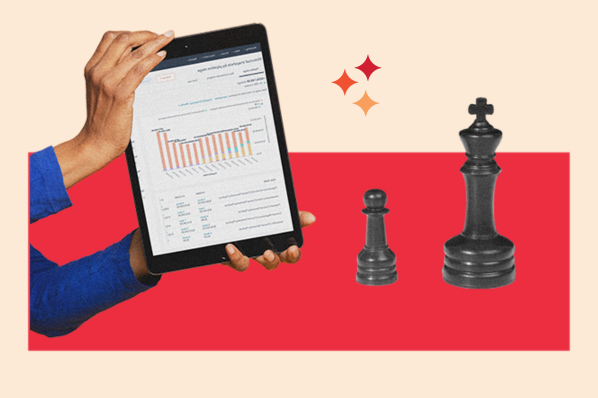Lead distribution can be tricky because no two sales reps are the same. Each has their own strengths and shortcomings — qualities that ultimately shape how they sell. Similarly, every prospect has their own interests and needs, informing how they like to be sold to.

In many cases, those "hows" between reps and prospects can align — naturally making for smoother, more amicable sales efforts. That trend begs the question, "How can I ensure that the right reps are pursuing the most appropriate prospects?"
Well, the answer might lie in a practice known as lead distribution. Here, we'll explore the concept a bit further, review its fundamentals and best practices, take a look at some prominent lead distribution strategies, and see some of the best software solutions to support them.
Let's dive in.
What are the phases of lead distribution?
Lead Distribution Best Practices
What is lead distribution?
Lead distribution is a process where a sales org strategically assigns individual leads to the specific reps best suited to sell to them. It rests on the premise that every lead has its own needs and interests that align with certain reps' personal strengths and skillsets.
Leads are unique. They all have preferences and pain points — specific to factors like their scale, industry, location, and market position.
The same goes for your salespeople. As I mentioned, no two of them are the same. Lead distribution plays on those trends. It allows you to match reps with the leads that will be most receptive to their personal brand of sales.
This typically automated process can help you trim some fat from your sales org's broader performance. By pairing salespeople with the types of leads they have the acumen to handle most effectively, you can ensure that you're making the most out of your organization's opportunities.
What are the phases of lead distribution?
- Capturing and Delivering Leads
- Screening for Quality
- Setting Criteria and Standards
- Transparency and Keeping Reps Posted
As I mentioned, lead distribution is usually an automated process, but there are still some key actions you need to take to ensure you get as much as you can of your strategy. We explain what you should do in each phase of lead distribution below.
Phase One: Capturing and Delivering Leads
It might go without saying, but you can't distribute leads without any leads to distribute.
Any solid lead distribution strategy starts with an effective lead capture and delivery process — generally supported by automated lead generation resources. Leads need to transition from marketing to sales as seamlessly as possible, and those kinds of tools can facilitate that process.
Phase Two: Screening for Quality
Lead distribution can only be so efficient and effective if your leads aren't properly screened for quality. You need to know that the leads your sales reps will ultimately pursue are legitimately suited for your product or service.
You have to consider factors like a company's scale, financial circumstances, business needs, and any other element that dictates what and how a prospect is going to buy. From there, you can weed out prospects that aren't worth your time — providing your sales reps with a better, more refined, viable crop of leads.
Phase Three: Setting Criteria and Standards
The whole point of lead distribution is pairing reps with the leads they're best equipped to handle — that can't happen arbitrarily. And unless you're planning on putting a sizable time commitment into distributing leads manually, you need to have firm criteria for identifying which leads should go to which reps.
The key factors at play with this step will vary from business to business and team to team, but they generally include elements like reps' regional knowledge, experience, seniority, overall performance, and current commitments to other deals.
Phase Four: Transparency and Keeping Reps Posted
Your reps need to understand the logic behind your lead distribution strategy — so keep them in the loop about the criteria you set for the leads they're going to receive. They need a picture of who they'll be working with and an idea of why they're best equipped to handle them.
Letting them in on those elements of the process will help guide better-informed sales efforts and communication. It will also keep reps from being confused or dejected about receiving leads they might be struggling with. It might even help to include your reps in the criteria-setting process.
You'll also want to immediately notify reps of incoming leads as soon as you can. Your team needs to stay on top of their outreach — lead distribution can only be so effective if you're not consistently making something of the leads that come in.
Lead Distribution Strategies and Methods

1. Round Robin
The "Round Robin" method is one of the more straightforward lead distribution strategies sales orgs have at their disposal. Here, your reps automatically receive an evenly distributed volume of leads in the same order — without much tiering or criteria-based screening.
Round Robin’s primary draw is in its simplicity. This method is not particularly difficult to implement and track.
That said, it's one of the less sophisticated strategies listed here. The method often doesn't account for reps' strengths, availability, or experience as much as others.
2. Cherry Pick
The "Cherry Pick" strategy offers reps more autonomy and agency in the lead distribution process. With this method, salespeople are allowed to select their own leads out of an existing pool and pursue them as they see fit.
This process can foster healthy competition and a sense of urgency within a sales org. Reps are pressed to take initiative, put in extra effort, and try to prove themselves.
That said, this method also leans on the fact that certain leads are much more desirable than others. If you give your reps their choice of leads, you might wind up leaving smaller or more challenging deals on the table.
3. Region-Specific
The "Region-Specific" strategy is relatively self-explanatory. It involves partitioning groups of leads by geographic area and delegating the distribution process to the territory managers that cover each region.
This method allows you to account for reps' knowledge of regional preferences, location-specific needs, and the most prevalent personas by area. However, not all regions are created equal.
Some are much more active and lucrative than others. If you opt to go with this strategy, you run the risk of sacrificing efficiency and appearing to favor certain subgroups of reps. These two factors can undermine your sales org's morale.
4. Shotgun
The "Shotgun" strategy starts with grouping reps by their strengths, skill sets, and experiences. Once you have those groups established, you divide your leads among them based on fit and relevance. From there, the reps who comprise each group claim leads on their own.
This method is one of the more focused strategies listed here. It lets you match leads with reps who are particularly well-equipped to handle them. A shotgun approach can also foster a healthy competitive spirit within a sales org, but it rests on you having enough leads to go around.
If you have a disproportionately low number of leads relative to your number of reps, your team's morale can take a hit. This strategy also assumes your salespeople have a certain degree of integrity and selflessness that isn't always there. Encouraging "lead-hoarding" is a risk you run with this method.
5. Manual
"Manual" distribution is exactly what it sounds like — personally designating leads for your reps, yourself. It gives you a degree of control over the lead distribution process that no other strategy listed here can match. The strategy allows you to faithfully adhere to the criteria you use to set reps apart from one another.
If you thoroughly understand how your reps operate, you can leverage this strategy to play to their strengths.
This method comes with its share of drawbacks. As you can probably assume, manual distribution is extremely labor-intensive. If you're working with a larger team, there's a good chance it won't be worth the effort.
Lead Distribution Best Practices
Looking to improve your lead distribution strategy? Start with these best practices.
Automate to save time and personalize for bigger sales.
Automation should only be used when it will both save your team time and close deals faster. However, there are definitely leads that could use a personal touch.
When you know a lead has a higher lead score or is a potentially large sale, consider doing research on LinkedIn to identify their likes, dislikes, and potential needs. This will give you a leg up during initial conversations, as well as make your customers feel important.
Retain and reward top sales representatives.
Lead routing and assignment are only as successful as your top sales talent. Make sure you have a fair and consistent process in place for lead distribution. If not, you may risk losing some of your best sales reps.
You can monitor how successful a sales rep is by analyzing payment revenue. This can help you identify top performers and reward them with a larger commission or another incentive.
Make sure your sales reps understand any sales goals and can visualize their place on a sales leaderboard.
Be flexible.
What works for one sales team won’t work for another. Sometimes you have to try out a process before you can pinpoint what works and what doesn’t.
You may commit to a lead distribution method and find that sales reps are unmotivated or confused. If so, it’s time to reevaluate.
Consider trying out sales distribution methods until you find the one that works the best. Ask your sales reps to fill out anonymous surveys on what could be improved, implementing any feedback quickly.
Getting Started
If your team is just getting started, consider your organization’s strengths and weaknesses. You can then find a lead distribution method that is likely to work best. From there, test and iterate on your approach. Soon, the right reps will always be serving the right customers.






![How to Develop a Strategic Plan for Business Development [Free Template]](https://blog.hubspot.com/hubfs/Copy%20of%20Featured%20Image%20Template%20Backgrounds-2.png)




